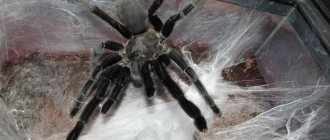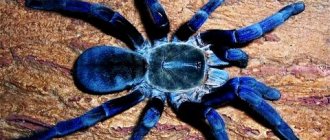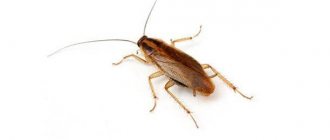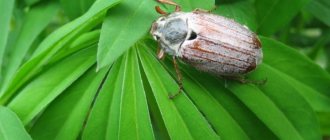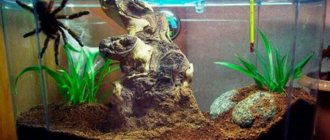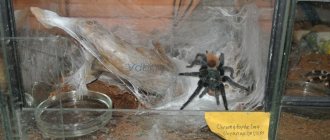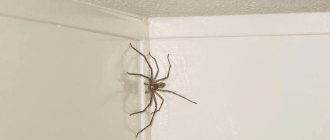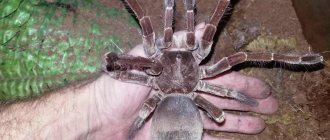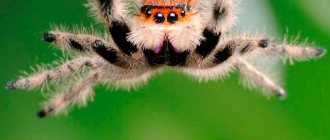You can watch a spider's meal for a long time. Feeding spiders is a truly fascinating spectacle. Seeing the victim, the spider rushes at it and instantly injects poison into the body. The poison immobilizes the prey, and the spider, slowly weaving it with a web, releases gastric juice into the prey and begins to eat. The feeding of spiders turns into a whole performance. But what should you feed a regular spider to ensure its long existence? How is feeding a tarantula spider different? To understand what to feed a spider at home, you need to understand what constitutes the diet of arthropods in their natural habitat.
Diet of house spiders
How often to feed a spider
Eating food every day is unnatural for spiders. Feeding your pet should happen no more than 1-2 times a week. It is also necessary to monitor the size of the abdomen; after eating the food, it should not grow more than 2 times. Otherwise, overeating threatens abdominal rupture and death.
If the spider refuses food, there is no need to sound the alarm. Temporary hunger strikes lasting a couple of weeks, or even a month, are completely normal.
What to feed a spider
The basis of your pet's diet should consist of food insects. Spider food is available in many pet stores.
It is better to create a diet for the spider from insects of a suitable size relative to the size of the pet itself. It is the choice of the spider owner to grow prey for your pet yourself or buy it from trusted places.
It is necessary to have a special container with water in the terrarium. The spider needs it in its diet every day, unlike food. Water should always be clean and fresh.
Why you can’t feed the tarantula spider insects from the street:
Insects from the street are subject to various risk factors, such as food poisoning, poisoning with toxins, and other harmful substances. There is also a high risk of infection by various parasites. For example, I saw a video in which about 20-30 parasitic worms were taken out of a grasshopper caught on the street with tweezers, which can also infect your tarantula spider.
If for some reason you decide to feed the tarantula spider insects from the street, then try to collect insects away from the city and roads. Also carefully examine the caught insect for the presence of visible parasites, and rinse with water. A small quarantine would not hurt to identify possible diseases of the caught insect.
Preparing feed yourself
You can prepare food for your beloved pet yourself. This saves money and time for frequent trips to the pet store. It is not difficult to breed marbled cockroaches, which are a delicacy for spiders in their regular diet. You can grow a colony of cockroaches in a glass jar. You need to throw bark and cardboard at the bottom of the container and put 10-20 individuals there. Marbled cockroaches reproduce quickly and are not picky about food. You can feed them vegetable scraps, bread crumbs and small pieces of meat.
To prevent cockroaches from escaping, you should coat the edges of the jar with Vaseline. When selecting food for a spider’s diet, it is better to collect young cockroaches that have not yet acquired wings. Such victims are suitable for both an adult spider and a small growing pet.
Important tips for feeding spiders:
- You cannot leave the corpse of an insect in the terrarium if decomposition has occurred. Corpse poisons are extremely harmful to your pet.
- Feeding the spider immediately after molting is not advisable. Insects can harm a spider that has just survived its molt.
- It is necessary to immediately remove the remains of the spider's meal.
- It is not advisable to freeze food for further use. Many spiders will simply refuse stale food.
- If the insect turns out to be larger than the spider, you should cut it into pieces.
- If the spider refuses to eat, you need to crush the insect's head with a stone and leave it in the terrarium for a couple of hours. If more than 8 hours have passed and the spider has not touched the food, be sure to remove the corpse.
The key to a long and happy life for your pet is taking care of its diet. Myths that tarantulas should eat only vertebrates cannot be believed. Listening, or rather looking closely at the state of the spider, you need to feed it according to need, and under no circumstances overfeed it. Moderate nutrition, care for the cleanliness of the terrarium and frequent replacement of drinking water are to the taste of all domestic spiders on the planet.
What does a tarantula eat in nature?
Although these spiders are unpretentious in care, their feeding should still be as close as possible to natural nutrition, which is the main rule for keeping tarantula spiders at home.
At home, conditions close to natural should be created for the tarantula spider.
Some may think that tarantulas are spiders that eat birds. Despite their name, these spiders do not feed on birds. Although individuals measuring 23 cm are capable of eating small birds, they pay attention to such prey very rarely.
Tarantulas hunt at night once every 7-10 days. Like tarantulas, they wait for prey in a shelter. They do not build trapping nets, but they place spider threads along the feeding area, which they pull into their home. By the vibration of the threads, the spider can recognize who is approaching: a beetle, a lizard or a mouse.
It kills the victim by injecting it with a paralytic poison located in the chelicerae. Tarantulas are toothless, and their oral cavity works like a pump. After the venom dissolves the insides of the prey, the spider sucks out the resulting nutrient mixture.
Spiders kill the victim by injecting poison into it, which is located in the chelicerae
In natural conditions, tarantulas eat:
- insects of different sizes;
- insect larvae;
- small rodents;
- lizards;
- frog.
Spiders do not feed on carrion.
Nymphs emerging from eggs do not require nutrition. They live in a special shelter made of a dense layer of cobwebs.
The larvae emerge from the nest and begin to get their own food. They feed on the larvae of beetles, flies and earthworms found in the ground, which happens once every 3 days. Small tarantulas do not yet hunt adult beetles. Their elastic chelicerae do not allow them to bite through the hard chitin shell of a large insect.
Features of choosing a pet
In order to choose a healthy spider, you need to use a few simple tricks that will help protect yourself from wasting money:
the arthropod must be active and playful
In the case when the specimen you have chosen lies alone on the sidelines, is passive and constantly hides in the house, the animal is most likely sick, and you should not buy such a pet for home;
a healthy spider's abdomen should be even and smooth. If the abdomen is wrinkled or has other pathologies, the spider suffers from dehydration and may soon die; open wounds or ulcerative defects on the body of a tarantula are another reason to refuse to purchase such a spider;
It is best to purchase small spiderlings, since it is almost impossible to determine the age of a tarantula by appearance;
It is important to pay attention to the hairs that cover the abdomen. If they are not evenly distributed throughout the body or vary in size, the animal has health problems; the absence of paws in most cases is not a pathology, since they will instantly grow back after the next molt. This only means that the animal was not transported properly.
https://youtube.com/watch?v=HMmZyw4Xxro
Important! When choosing a tarantula, you need to pay attention especially to females, since males are not distinguished by longevity and live several times less
Number of spiders
How many spiders are born at a time? Given that the clutch consists of a fairly large number of eggs, it is difficult to predict how many babies will see the light of day. A spider can weave one cocoon and lay 5 eggs in it. Or he can work on several with a total number of eggs of about a thousand. This happens extremely rarely. Most often, the number of cocoons with clutches reaches 10. Now imagine that each of them contains five eggs. And this means that fifty baby spiders will be born.
Arrangement of the terrarium
For terrestrial spiders, horizontal terrariums are suitable, but for arboreal and climbing spiders, it is better to purchase a vertical terrarium. Its dimensions should be approximately 2-3 times the span of the legs. With a smaller space, the pet will experience mental discomfort, and with a larger space, more energy will be required to heat it, light it and maintain the required humidity.
It is necessary to purchase one lamp for irradiation with the ultraviolet spectrum at 15-18 W, and another for local heating. Spiders require a constant temperature ranging from 21°C to 28°C. Humidity, depending on the type, is maintained in the range from 55-90%. There must be a rigid ventilation mesh to provide fresh air and prevent the tarantula from escaping.
Tarantulas are very fragile creatures. They can easily injure their paws and abdomen when falling even from a small height or when coming into contact with sharp objects. When decorating the interior of their home, unnecessary clutter should be avoided.
The terrarium should be placed so that direct sunlight does not fall on it. Tarantulas are active at night or twilight, so bright lighting will deprive them of their usual rest during the day.
Family name
origin of name
One of the ancient engravings, the image on which served as the basis for the name - tarantula
The name “tarantula spiders” arose as a result of several engravings drawn by the German researcher and animal painter Maria Sibylla Merian and published based on the results of her stay in Suriname (1699-1701) in the work “Metamorphosis insectorum Surinamensium” (1705), where she observed like a large tarantula ( Avicularia sp.
) attacked the hummingbird in the nest.
Problems with the translation of the term
In a number of European languages, tarantulas, and sometimes all large spiders, are often called tarantula. In Russian, the word tarantula is used to designate spiders of a slightly different group, in particular including spiders, which are widespread in the south of Russia. In this regard, confusion often arises when texts are translated incorrectly. In modern biological systematics, the taxa “tarantulas” and “tarantulas” do not overlap; Tarantulas are mygalomorphic spiders, and tarantulas are araneomorphic.
Curious racers
Jumping spiders are also jumping spiders that are not dangerous to people, of which there are 6,000 known species. The body of the spiders is only 1 cm, with a flattened abdomen, raised cephalothorax and strong legs. The spider looks with 8 eyes arranged in three rows. The body and pattern are both light and dark in color.
Habitat: trees and shrubs; they appear randomly in apartments; they are able to move on glass surfaces.
They prefer to hunt in the daytime and without cobwebs. Interestingly, the female, having laid her eggs in a cocoon, guards the clutch until the babies appear. Then he grooms and brings food until the molt has passed. After this, the cubs run away to live on their own.
Further fate
Just as spiders are born, they sit hungry if their mother is not around. The spider feeds the babies for the first time until they moult. What should the orphan spiders do? They eat the yolk, which is prudently stored in their abdomen. And they patiently wait for the moult. Have they moulted, shed their baby skin and acquired a chitinous shell? Now you can learn to weave a web.
Rarely do any of the “babies” immediately leave their egg. Most baby spiders live in the remains of the shell for several months. And then they crawl out, and their paths with their brothers and sisters diverge forever.
True, not all representatives are like this. Crosses, for example, clump together. And they bask in the sun for a long, long time. Only then do they scatter. And tarantulas travel on their own mother. They climb onto her back and ride like that. When they grow up, the spider itself resettles its offspring. Drops them in different places from the back. Why not throw them all at once, they will have more fun together? And so that they don’t die of hunger.
By the way, about food. What do little orphan spiders eat, besides yolk? The yolk is running out, but I want to eat. It sounds terrible, but they eat their own mother’s body. Climbing out of the shell, the kids discover a shriveled, dead spider. Only they don’t know that it’s the mother in front of them. And the whole brood pounces on the food. So the spider feeds her children after her own death.
You can see how spiders are born in the photo. The sight is not the most pleasant, but it is useful for educational purposes.
Family name
origin of name
One of the ancient engravings, the image on which served as the basis for the name - tarantula
The name “tarantula spiders” arose as a result of several engravings drawn by the German researcher and animal painter Maria Sibylla Merian and published based on the results of her stay in Suriname (1699-1701) in the work “Metamorphosis insectorum Surinamensium” (1705), where she observed like a large tarantula ( Avicularia sp.
) attacked the hummingbird in the nest.
Problems with the translation of the term
In a number of European languages, tarantulas, and sometimes all large spiders, are often called tarantula. In Russian, the word tarantula is used to designate spiders of a slightly different group, in particular including spiders, which are widespread in the south of Russia. In this regard, confusion often arises when texts are translated incorrectly. In modern biological systematics, the taxa “tarantulas” and “tarantulas” do not overlap; Tarantulas are mygalomorphic spiders, and tarantulas are araneomorphic.
